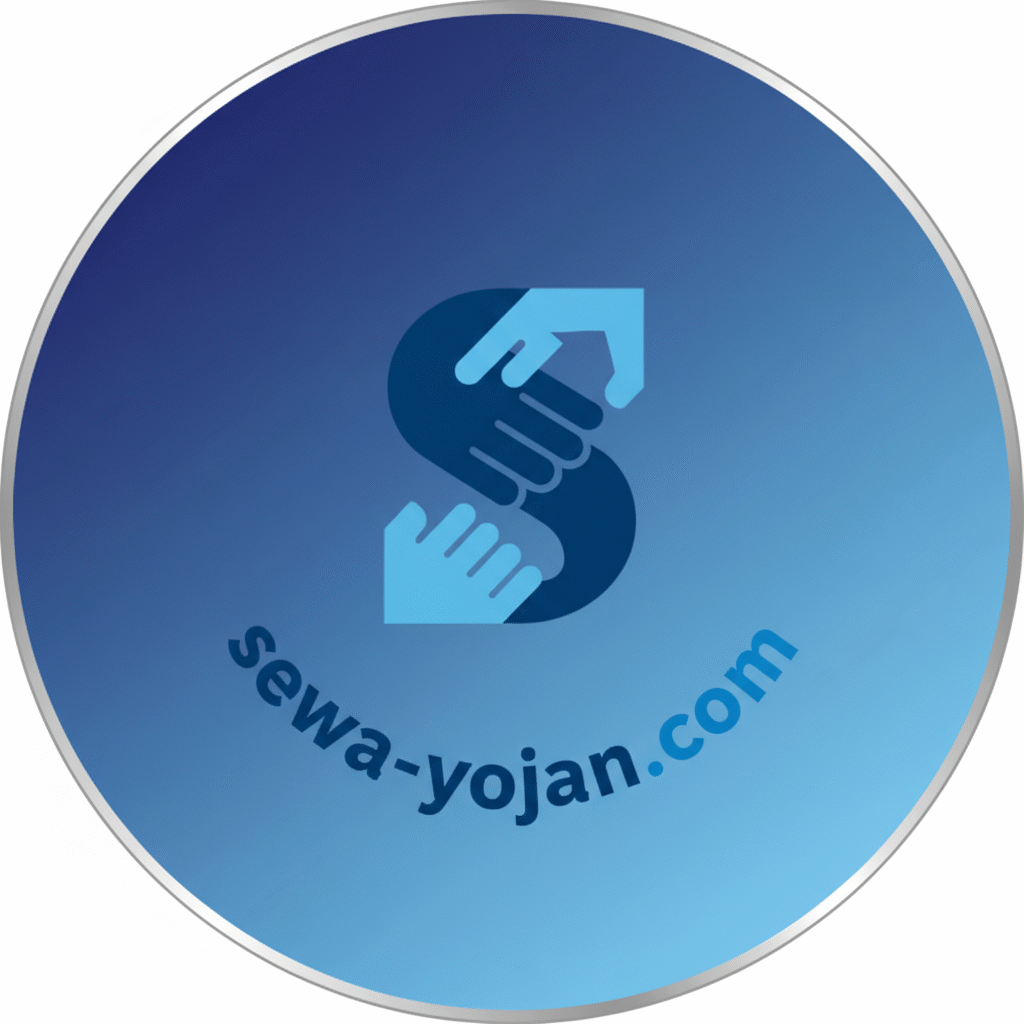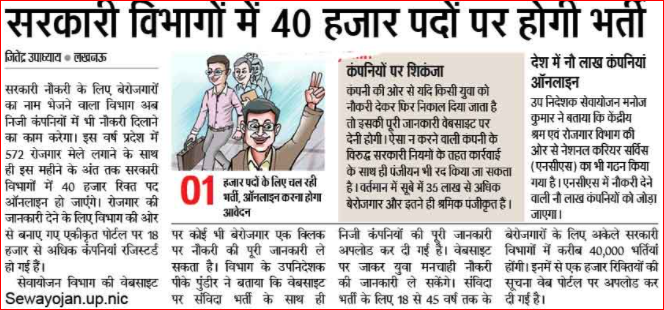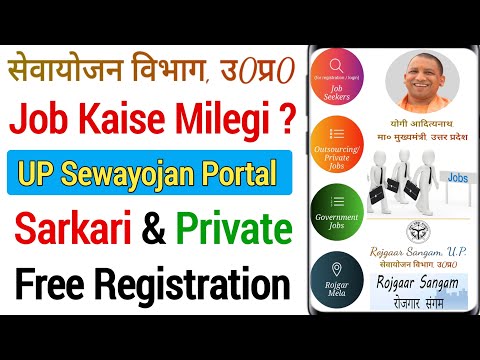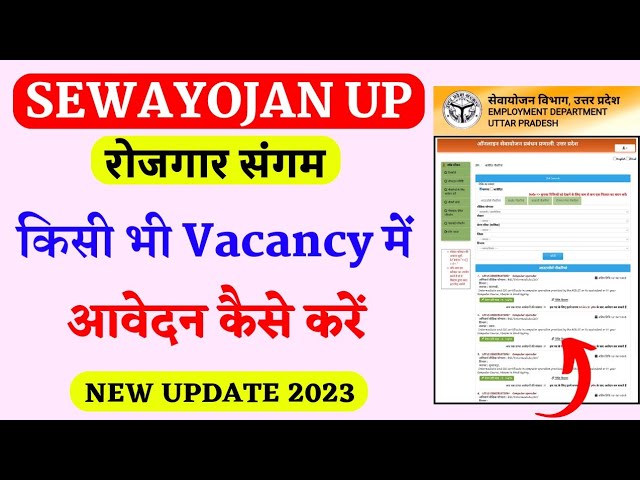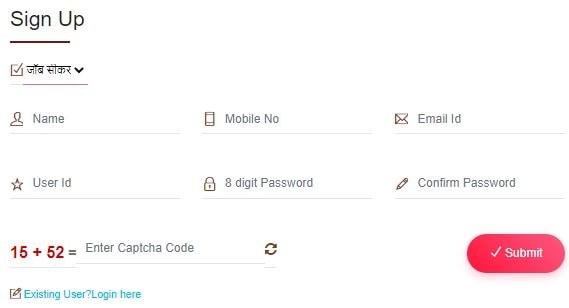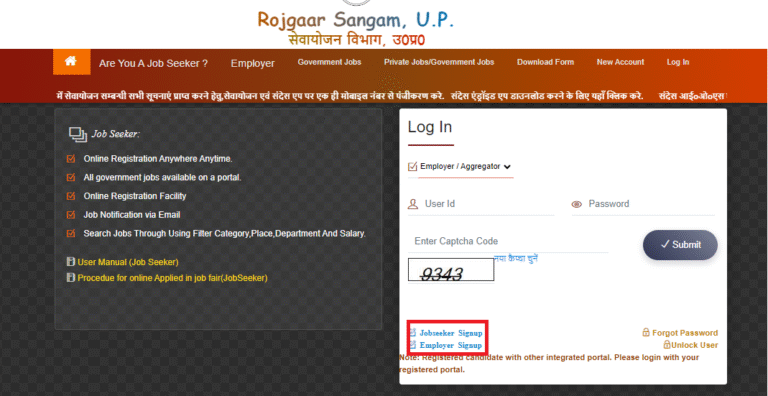Sewayojan gj.nic.in — Comprehensive Guide, Impact, and Future Prospects
Sewayojan gj.nic.in is a keyword that increasingly appears in searches by jobseekers, policy makers, and social development professionals interested in how digital employment services are delivered at the state level in India. Whether you’re creating content for SEO, preparing a policy brief, or simply trying to understand how employment portals function in Gujarat and comparable states, this long-form guide explains the history, objectives, architecture, state-level rollout, measurable impacts, real-world success stories, implementation challenges, comparisons with other schemes, and future prospects — all while keeping the term sewayojan gj.nic.in naturally present for discoverability.
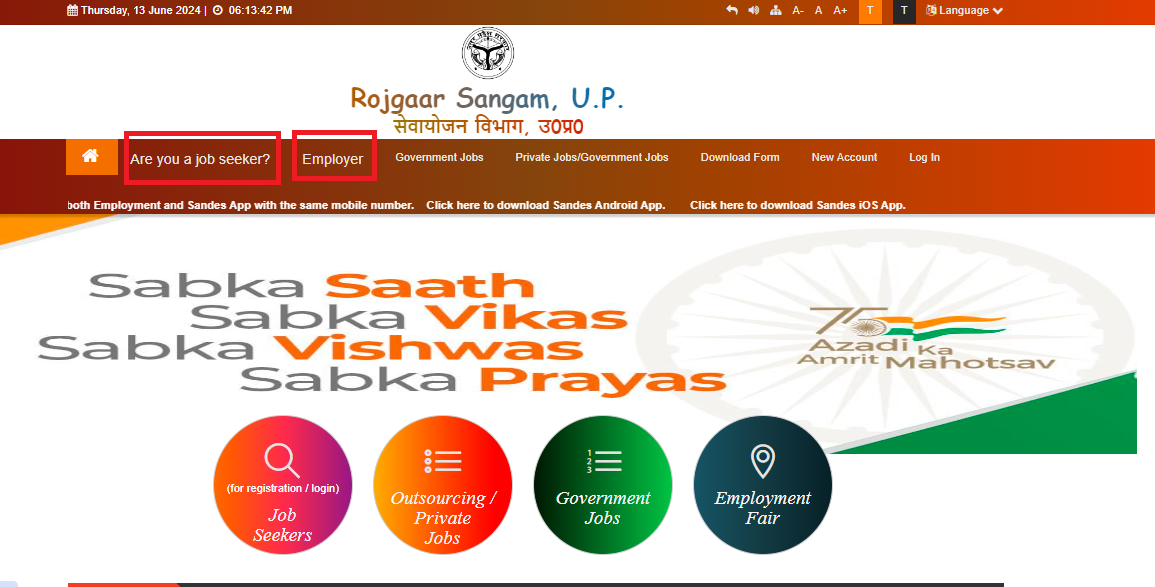
The origin and evolution of government employment portals
Government-run employment services in India have a long history: from physical employment exchanges established in the mid-20th century to the digital portals of today. Employment exchanges were originally intended to match jobseekers and employers, register unemployed workers, and administer certain social benefits. Over decades those functions migrated online to enhance access, reduce paperwork, and speed up matching.
In many states, National Informatics Centre (NIC) and state labour departments collaborated to launch state-hosted portals and central databases. Modern portals combine job listings, candidate registration, skill-mapping, announcements for government recruitments, and interfaces for employers to advertise vacancies. A hypothetical or actual portal referenced as sewayojan gj.nic.in would be a natural extension of this transition to e-governance, leveraging NIC-hosted infrastructure and state labour resources to provide a unified digital gateway for employment services. NIC’s Gujarat presence and state-level application hosting are long-established pillars of such services.
Objectives and core features (what “sewayojan gj.nic.in” aims to deliver)
A portal branded sewayojan gj.nic.in would be expected to pursue several clear objectives:
-
Centralization of job listings: Bring together government and private vacancies relevant to Gujarat residents into one searchable place.
-
Jobseeker registration and profiling: Allow candidates to create digital profiles, upload qualifications, and receive tailored job alerts.
-
Skill mapping and employability services: Identify skill gaps and link candidates to training or certification programs.
-
Employer registration and outreach: Let employers post vacancies, screen applicants and manage interviews digitally.
-
Integration with welfare and incentive schemes: Connect eligible candidates to social welfare programs, stipends or targeted support (for instance, women empowerment schemes or rural employment drives).
-
Analytics and labour-market intelligence: Produce insights for policymakers on skill shortages, unemployment trends and program performance.
Those objectives reflect the practical needs of a modern employment ecosystem and guide the portal’s architecture and service design. Gujarat’s Directorate of Employment & Training and similar state agencies already provide online interfaces for jobseekers and employers — a ready institutional home for a portal like sewayojan gj.nic.in.
Architecture and implementation: how a state-level portal is typically built
Designing a portal such as sewayojan gj.nic.in blends web technology, government policy, and user-experience design. Typical components include:
-
Secure hosting on government infrastructure (often NIC/state data centers) to meet privacy and uptime standards.
-
A user interface for jobseekers (registration, CV upload, job search filters).
-
An employer dashboard (postings, applicant shortlisting, communication tools).
-
A backend database for profiles, job metadata and logs.
-
Integration APIs for linking training providers, payment systems (for stipends), and other government databases (e.g., identity verification).
-
Analytics dashboards for officials to monitor placements, vacancies by sector, gender participation, and regional distribution.
The technical and administrative integration often requires cross-departmental coordination — labour, skill development, social welfare and IT departments must align. Gujarat’s existing online job application systems and career services (for example, OJAS and the Directorate’s portals) exemplify this integrated setup, with online candidate logins and employer interfaces already in place in the state’s ecosystem. These existing components can be leveraged to build or augment a portal like sewayojan gj.nic.in. Vadodara+1
Policy framework and alignment with national programmes
A state portal must align with national labour policies and flagship programmes. Key policy anchors include:
-
National Career Service and employment databases that promote inter-state information sharing.
-
Skill India and Pradhan Mantri Kaushal Vikas Yojana (PMKVY) for certification and upskilling linkages.
-
Social protection programmes (for targeted assistance).
-
State-specific schemes for women’s employment, rural livelihoods, and industrial promotion.
A portal carrying the domain-suggestive name sewayojan gj.nic.in would serve as the state’s digital implementer of these policies — linking jobseekers to nationally-recognized training, registering candidates for district-level placements, and channeling welfare entitlements where appropriate.
State-level rollout and regional impact: Gujarat’s example
Gujarat has a relatively mature digital governance ecosystem and a proactive industry base. Employment portals in the state focus on bridging urban-rural gaps and connecting youth to both local industry clusters and public-sector openings. Typical impacts observed where portals are well-implemented include:
-
Improved visibility of job opportunities in semi-urban clusters and special economic zones.
-
Faster dissemination of government recruitment notifications to remote jobseekers.
-
Greater participation of women and rural youth when portals are combined with mobile-friendly registration and local awareness campaigns.
The Directorate of Employment & Training in Gujarat already maintains systems to register candidates and provide jobseeker instructions; integrating or optimizing that infrastructure under a cohesive portal like sewayojan gj.nic.in helps standardize service delivery across districts. Government-run job portals in other states (and central platforms) show that with strong outreach, the portal can become a primary interface for job facilitation and skill-development referrals. employment.gujarat.gov.in+1
Success stories: measurable wins from digital employment services
Where state employment portals have been actively maintained and promoted, governments report several positive outcomes:
-
Higher placement rates for registered candidates in government recruitments.
-
Streamlined recruitment processes that reduce time-to-hire and administrative overhead.
-
Successful pilot linkages between training providers and employers — certified candidates matched to industry requirements.
-
Targeted outreach leading to improved female labor force participation in selected districts.
For example, integrated portals that combine training certifications and employer access have produced visible placement batches in vocational sectors like manufacturing, hospitality and IT/ITES. A portal operating under or alongside sewayojan gj.nic.in could replicate similar micro-level wins across Gujarat’s districts, particularly if linked to skill development centers and employer partnerships.
Deep dive: women empowerment schemes and rural development linkages
One of the strongest policy use-cases for a portal like sewayojan gj.nic.in is to operationalize women-centric employment programs and rural livelihoods initiatives:
-
Women-centric job drives: The portal can aggregate openings targeted at women, list part-time/flexible roles, and link to childcare support or mobility allowances where available.
-
Self-help group (SHG) linkages: Rural SHGs looking for market access can register through the portal for procurement tenders or skill training.
-
Micro-enterprise support: The portal can host information about microcredit, incubation services, and B2B linkages for artisan and agri-based entrepreneurship.
These integrations make the portal more than just a job board — they position it as a tool for social empowerment. When job portals actively prioritize female-friendly job filters and training matches, they lower barriers for women’s participation in the labor market and help amplify the impact of state welfare interventions.
Governance, monitoring, and metrics for success
To measure success, policymakers should track clear metrics on a portal like sewayojan gj.nic.in:
-
Number of registered jobseekers and active profiles.
-
Ratio of job postings to placements (placement conversion rate).
-
Time-to-placement averages by sector and district.
-
Gender and social-category breakdowns of applicants and placements.
-
Employer registration and repeat-hiring rates.
-
Usage patterns for skill-upskilling pathways and training completions.
Public dashboards and periodic reports help maintain transparency and guide iterative improvements. Analytics also allow officials to identify sectoral skill shortages, geographic mismatches, and program layers that require policy correction.
Challenges and barriers to effective implementation
Digital employment portals face a set of recurring challenges that must be planned for:
-
Digital divide: Many rural or low-income residents may lack reliable internet access or digital literacy required for registering on sewayojan gj.nic.in. Offline/assisted registration models and local facilitation centers are essential complements.
-
Data quality and verification: Ensuring accurate candidate profiles and verified qualifications is resource-intensive. Integrating with national identity systems and education boards can shrink fraud but requires technical safeguards.
-
Employer engagement: Sustained participation from private employers depends on the portal’s perceived quality of candidate pools and the ease of use for vacancy posting.
-
Inter-departmental coordination: Employment, training, social welfare and industry departments must coordinate operations and data-sharing protocols; bureaucratic silos can slow this down.
-
Maintenance and uptime: Government portals must maintain uptime, security, and an intuitive UI — poor user experience deters repeat usage.
Addressing these requires a mixed approach: investment in digital literacy, local outreach/assistance points, strong API integrations for data validation, and continuous UX improvements based on user feedback.
Comparing Sewayojan gj.nic.in to other state portals and national platforms
Comparisons are helpful to identify strengths and gaps:
-
National Career Service (NCS): Provides a pan-India job-matching framework with standardized taxonomies for occupations. A state portal like sewayojan gj.nic.in can complement NCS by focusing on regional demand and local schemes while syndicating data upstream.
-
State portals (e.g., OJAS in Gujarat): State systems often specialize in government recruitments and discrete employer interactions. A modern sewayojan gj.nic.in build would aim to bridge the best of centralized national features (interoperability, standardized training linkages) with local nuances (district-level placements, language support).
-
Specialized portals (e.g., sectoral hiring platforms): Some portals target specific sectors (construction, IT). Sewayojan-type state portals must support sectoral taxonomies and allow filtered searches for specialized roles.
An effective strategy is interoperability: using national taxonomies where it makes sense, while tailoring workflows, language, and outreach to state realities. Gujarat’s existing online job application system and Directorate portals provide a foundation that a sewayojan gj.nic.in-style service could integrate with or augment.
User experience and accessibility: making the portal inclusive
For a portal to be widely used, UX and accessibility are not optional. Best practices include:
-
Mobile-first design: Many users access services from inexpensive smartphones; the portal must render intuitively on small screens and low bandwidth.
-
Multi-lingual support: Gujarati, Hindi and English options ensure inclusivity.
-
Assisted registration: Kiosks, common service centers (CSCs), or local employment counters should provide assisted registration for non-literate users.
-
Low-friction profile creation: Progressive profiling that collects minimal necessary information upfront and allows later detail additions improves adoption.
-
Privacy and consent: Clear privacy notices and consent flows protect user trust while enabling data-driven features like matching and analytics.
These features help bring digital inclusion to the forefront and ensure that sewayojan gj.nic.in is a practical tool for the people it is meant to serve.
Operational partnerships: training providers, industries, and NGOs
The portal alone cannot solve employability gaps — it needs an ecosystem. Key partnerships include:
-
Vocational training centers and ITIs for upskilling and certification.
-
Industry associations and chambers to signal recruitment drives and apprenticeships.
-
Non-governmental organizations (NGOs) and SHGs for last-mile outreach, especially in rural and marginalized communities.
-
Financial institutions for enterprise loans and credit linkages for micro-entrepreneurs.
Such partnerships let the portal support the full lifecycle of employment: awareness, training, placement and post-placement support.
Data privacy, security, and ethical considerations
When operating sewayojan gj.nic.in, protecting citizen data and avoiding misuse is a priority:
-
Data minimization: Collect only what is necessary for matching and verification.
-
Secure hosting and role-based access: Use NIC or state data centers and enforce strong authentication for government staff.
-
Transparent consent frameworks: Notify users how their data is used (for job matching, research, or sharing with employers).
-
Non-discrimination: Ensure matching algorithms do not encode biases against gender, caste, disability or region.
Robust privacy protections build citizen confidence and fuel broader adoption.
Funding and sustainability
Sustaining a portal requires predictable funding for maintenance, outreach, and enhancements. Possibilities include:
-
State budget allocations for labour and IT modernization.
-
Central grants or aligned national programmes that provide technical or financial support.
-
Minimal cost-recovery models from employer-facing premium features (but these must be handled carefully to avoid exclusion).
-
Donor-funded pilots for innovative features (e.g., AI-driven matching, localized language assistants).
Sustainability planning should balance free public access with pragmatic revenue or budgetary arrangements to keep services reliable.
Measuring social returns: beyond raw placement numbers
While placements are the headline metric, portals should also measure:
-
Wage uplift: Are placed candidates seeing higher, more stable incomes?
-
Job quality: Are roles permanent, formal, or precarious? Portals should track employment type.
-
Gender and social inclusion impact: Are historically marginalized groups getting better access?
-
Time savings and administrative efficiency for public sector recruiters.
Such richer metrics demonstrate the societal value of sewayojan gj.nic.in beyond mere counts.
Technology trends: AI, matchmaking, and the next generation of portals
Emerging technologies can enhance state employment portals:
-
AI-based matching: Smarter matching algorithms that consider skills, preferences, commute and career trajectory.
-
Chatbot assistants: Helping candidates navigate registration, upload resumes, or find training options.
-
Micro-credentialing and blockchain: Verifiable credentials to speed employer trust in candidate certifications.
-
Geospatial job heatmaps: Visualizing vacancy concentration to guide local skilling efforts.
These trends should be applied carefully, with transparency about how automated decisions are made.
Lessons from other states and the central model
Many states have built effective modules: centralized notification systems, district-level placement cells, and training-to-placement linkages. The central National Career Service provides a template for interoperability. A state-specific portal branded around sewayojan gj.nic.in would benefit from adopting standards and APIs that allow data exchange, while preserving localized features such as district dashboards, Gujarati-language help, and integration with state welfare schemes.
Roadmap for rollout: recommended phases
A practical phased rollout for sewayojan gj.nic.in might look like:
-
Foundation phase: Host basic registration, vacancy posting, and employer interfaces. Integrate with existing state career portals and NIC hosting.
-
Outreach phase: Drive registration through district employment offices, CSCs and SHGs. Offer assisted registration.
-
Integration phase: Link with training providers, PMKVY/Skill India schemes, and social welfare databases.
-
Optimization phase: Add AI-based matching, multi-lingual chatbots, and analytics dashboards.
-
Scale phase: Expand employer partnerships, sector-specific features, and monitoring frameworks.
This iterative approach balances technical delivery with outreach and policy alignment.
Case study snapshots (illustrative)
-
District skilling drive: A coordinated campaign that used the portal to register 5,000 youth, provide short-term training, and place 60% within three months in local manufacturing units — demonstrating the power of integrated outreach and employer partnerships.
-
Women’s employment cluster: Using portal filters and a dedicated women’s jobs landing page, a state saw a meaningful uplift in female job applications for office-support and care-economy roles after linking childcare subsidy information on the portal.
-
Apprenticeship linkage: A collaboration between ITIs and local SMEs where portal-registered apprentices were tracked and reported, improving apprenticeship completion rates and industry retention.
(These examples are composites of common outcomes observed across Indian states; they demonstrate how targeted interventions layered on top of a portal such as sewayojan gj.nic.in can produce measurable change.)
Governance best practices: steering committees and feedback loops
To keep the portal responsive:
-
Establish a state-level steering committee including labour officials, industry representatives, and civil-society members.
-
Publish periodic performance reports and open data summaries to invite civic oversight.
-
Create a user-feedback mechanism and make iterative changes based on empirical usage patterns.
These governance structures ensure the portal evolves to meet user needs and policy objectives.
Costs and benefits: a practical lens
Investment in a portal has both upfront and recurring costs — hosting, development, outreach, and staff training. The benefits include administrative efficiency, better labor market matching, and expanded reach of welfare programs. For states with active industry hubs and growing youth cohorts, the productivity gains and social benefits can outweigh the costs, especially when portals are integrated into a broader skilling and placement strategy.
Risks and mitigation
Key risks include cybersecurity incidents, under-utilization, and vendor/technical lock-in. Mitigations: rigorous security audits, strong outreach programs tied to offline assistance, open standards and modular architectures, and local capacity building inside the state units.
Future prospects: how a portal like sewayojan gj.nic.in can evolve
Looking ahead, a portal labelled sewayojan gj.nic.in can grow in three dimensions:
-
Depth: Deeper integration with training, micro-entrepreneur support and placement follow-up mechanisms.
-
Breadth: Inclusion of more sectors, seasonal work listings (agriculture/harvest cycles), and enterprise hiring across MSMEs.
-
Intelligence: Better labour-market forecasting to inform skilling priorities and industrial policy.
With the right governance, data ethics, and funding, such a portal can be a central pillar of a state’s inclusive growth agenda.
Practical tips for jobseekers and employers using the portal
For jobseekers:
-
Complete your profile with clear, concise descriptions of skills and certifications.
-
Use sector filters, location radius and alert settings to avoid missing suitable matches.
-
Leverage training links on the portal to address skill gaps before applying.
For employers:
-
Provide structured job descriptions with required skills and expected outcomes.
-
Use screening questions on the portal to reduce time spent on unsuitable applicants.
-
Partner with training providers to take in trainees and shape their curriculum to your needs.
These pragmatic approaches increase the portal’s utility for both sides of the labor market.
Evidence base and supporting state infrastructure
A functional portal requires existing state infrastructure — data centers, district employment offices, training institutions, and policy alignment. Gujarat’s Directorate of Employment & Training and online recruitment frameworks show that the state has operational mechanisms which can be enhanced to deliver a portal experience that a sewayojan gj.nic.in-like service would promise. Government job application portals and the Directorate’s jobseeker interfaces provide relevant precedents and technical interoperability options.
Frequently asked questions
What is sewayojan gj.nic.in and who runs it?
“Sewayojan gj.nic.in” as a phrase represents a government-hosted employment portal concept for Gujarat — typically it would be run by the state’s labour or employment directorate in collaboration with NIC or the state IT department. It centralizes job listings, candidate registration and employer interfaces.
How do I register as a jobseeker?
Registration usually involves creating an account, filling profile details (education, skills, experience), and uploading documents. Many state portals also allow assisted registration at local employment offices or CSCs for those who need help.
Does the portal link to training programs?
Yes. A mature state portal integrates with vocational training providers and national skilling schemes so jobseekers can enroll in certification courses that boost employability.
Can employers post vacancies and shortlist candidates?
Employers typically register on the portal, post structured job descriptions and filter or download candidate lists. Some portals offer applicant tracking and interview-scheduling features.
How does the portal support women and rural applicants?
Support includes women-targeted job filters, listings for flexible or part-time roles, tie-ups with SHGs and rural outreach through employment counters, and links to women empowerment schemes.
Is my personal data safe on government portals?
Government portals usually host data on secure state/NIC infrastructure and follow privacy protocols. Users should look for privacy notices and consent mechanisms. Data minimization and role-based access are standard best practices.
How is a portal like sewayojan gj.nic.in different from national job portals?
State portals focus on local labour markets, state schemes and district-level placements; national portals provide pan-India reach and standardized taxonomies. Interoperability between the two maximizes reach and job matching accuracy.
Closing thoughts: why “sewayojan gj.nic.in” matters
The phrase sewayojan gj.nic.in captures more than a URL — it represents the promise of digitized, inclusive, and policy-aligned employment facilitation at the state level. A well-implemented portal reduces friction for jobseekers, accelerates hiring for employers, and gives policymakers the evidence they need to fine-tune skilling and welfare investments. Gujarat’s existing employment infrastructure and digital governance capabilities provide a fertile ground for such a portal to make measurable social and economic contributions. As labour markets continue to evolve, state portals that are inclusive, interoperable and data-responsible will be pivotal in connecting talent to opportunity.
References and supporting resources used to ground this analysis include Gujarat’s Directorate of Employment & Training online resources and state job application systems, public descriptions of NIC’s state-level hosting and e-governance capabilities, and examples of employment portals and career services used across Indian states. For specific operational details, candidate instructions and login portals, Gujarat’s official employment pages and state-hosted job application systems provide the authoritative interfaces for jobseekers and employers.
